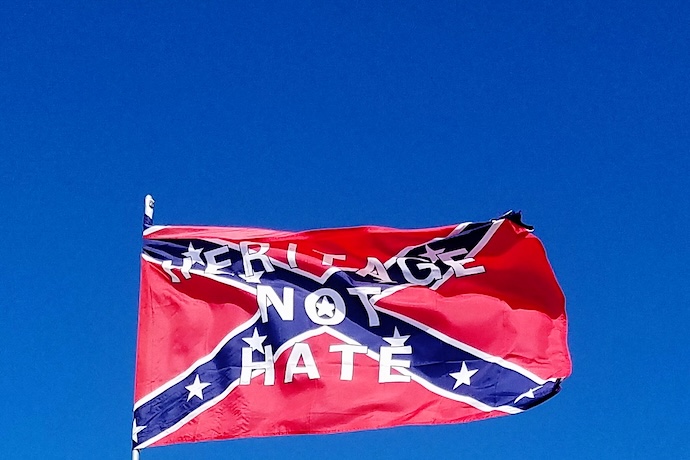Yes, the Democrats will someday come to be ashamed of and to regret their shameless support for the disgusting and xenophobic Laken Riley Act, as Michelle Goldberg predicts.
But how long will it take? And are we now so deer-in-the-headlights petrified by the imminent Trump onslaught and the pure evil of the criminals in charge that we can’t focus at all on the problem of Democratic accommodation?
We know, or ought to know, how outright collaboration, coupled by far too weak resistance (accommodation), has woven a slimy path through the fabric of our national past (not only ours, obviously: hello, France and Holland). But no one should bet the farm on the strength of American historical awareness.
This might be a good time to recall where the politics of accommodation can take us. And no, I am not thinking here of German elites accommodating themselves to Hitler. I have in mind the 1870s and 1880s in this country, when far too many former friends of abolition democracy were only too willing to oblige White Southern determination to keep the old order in place. In this case, the Northerners, many of them former Abolitionists, enjoyed a preponderance of power but chose to cede it for the sake of national “reconciliation” at the expense of Black people.
I realize that for the analogy to work, the elements gaining power today would need to be every bit as morally reprehensible as the South’s racist “Redeemers” and the terrorists who presided over the Jim Crow regime. And today’s accommodators would have to be as dishonorable as the craven Northern accommodators of that same era. Are they? Is it fair to compare a weak-kneed 2025 Democratic response to Trumpism to the weak-kneed (and sometimes corrupt) 1875 Northern accommodation of violent insurrectionists?
Let’s understand the aggressors first. Setting aside the president’s channeling of Mein Kampf and White supremacist dinner guest, most Trumpists steer clear of using explicitly White supremacist language. But when they speak of serving “real Americans,” of punishing all exponents of “wokeness,” and of the wholesale deportation of immigrant groups of color, it’s hard to miss the racist core of their project. A project centered on making America great “again” clearly points to a belief that the bygone days of unquestioned White supremacy exhibited the requisite degree of greatness.
Diehard Southerners used to proclaim “The South Will Rise Again!” They don’t proclaim it now, because they don’t have to. It’s clear enough that the Old White South has risen, more than once, and always with a vengeance. First in the abandonment of Reconstruction; then in Richard Nixon’s “Southern Strategy” fueled by White backlash to the civil rights movement; and finally with the triumph of Trumpism in the wake of Obama’s presidency. Each of these risings has been leavened by a White evangelical Christianity that also has its roots in the South’s humiliation of 1865.
Historian Richard Slotkin recently published an impressive summation of his work, addressing the theme of regeneration through violence that has animated all of his writing about US history for the past half century. Slotkin’s new volume, A Great Disorder: National Myth and the Battle for America, ends with a chapter that envisions Donald Trump as the last Confederate president and notes that today’s ongoing culture wars “are not simply quarrels about issues like abortion and gun safety. They are disagreements about the fundamental character of American nationality and the purposes of the American nation-state.”
Several themes explored by Slotkin are highly relevant to what many are calling the latest “realignment” in US political history. I will mention just three.
Plutocratic populism
Slotkin notes how the South’s dominant political class of the 1840s and 1850s—the major planters—was able to keep yeoman farmers and small-scale planters in line. These dominators fashioned an ideology “assigning the highest value and power to the holders of wealth, which poor or working-class white people will accept as long as their superiority to nonwhite people is guaranteed.”
Slotkin observes that culture likewise trumped material interest in the xenophobic populism of the North’s “American, or Know-Nothing Party” during this same antebellum period. Of course, Slotkin was not the first to observe how the very wealthiest in a wealth-obsessed culture are able to forge alliances with working class White people who, by Marxian logic, ought to be their class enemies. Notably, it was W.E.B. DuBois, then a committed Marxist himself, who first explored the distorting effects of the “wages of whiteness” in his classic 1935 work, Black Reconstruction in America.
Today’s affluent White liberals, complaining about how lower-class Whites voted yet again against their own material interests, can never seem to grasp DuBois’s lesson: Whiteness rules all.
Immigration as a Black-adjacent threat to democracy
Writing in 1877, Nation publisher E.L. Godkin, once a stalwart Abolitionist, echoed Southern “Redeemer” politicians’ condemnation of Blackness. Godkin specifically analogized what he saw as the ethnic immigrant threat to the White South’s challenge:
Vast additions have been made to our population…to whom American political and social ideals appeal but faintly, if at all, and who carry in their very blood traditions which give universal suffrage an air of menace to many of the things which civilized men hold most dear.
Slotkin notes that the turncoat Godkin was hardly alone in lumping immigrants and Blacks together as undesirables. Harvard president A. Lawrence Lowell also compared immigrants from Southern and Eastern Europe to Black people and Indians: “beaten men from beaten races, representing the worst failures in the struggle for existence.” Real Americans of Anglo-Saxon stock, Lowell argued in 1890, cannot expect to live freely alongside such inferior breeds. The un-American elements must therefore be barred from entering the country or else barred from participating in politics: precisely the “solution” that the Jim Crow states had by then put into practice in relation to the supposed menace of African American enfranchisement.
Today’s Trumpists describe the body of “real Americans” supposedly being polluted by immigration in much broader terms, as the old Anglo-Saxon shtick has long ceased to play very well. For example, Trump managed to win significant support from Latino voters despite Trumpism’s overt xenophobia (and it was no surprise to learn that many Trump-supporting Latinos are also evangelical Christians). But if what constitutes the besieged body has changed, the basic “pollution” meme remains in place and remains effective. Ending birthright citizenship would mark an epochal advance for the White supremacy project.
Valorized violence and mainstreamed misogyny
A close reader of American literature, Slotkin follows D.H. Lawrence in finding a hard and merciless masculinism rooted in this country’s settler colonial legacy. James Fenimore Cooper’s fictional Hawkeye character (modeled in part on Kentucky’s Daniel Boone) is the primary exemplar of masculine “pioneer” violence—a violence that always gets transmuted into heroism in the settler colonial mindset.
The South’s defeat did nothing to dim the allure of the vigilante as hero. White male valor and the preservation of White male honor got baked right into Lost Cause ideation, along with the insistence that White male violence also protects the purity of White women.
“Heritage, not hate” is how the Southern Way of Life is still marketed today. This gloss helps to sell millions of insecure White men on the idea that stamping out the transgender menace and restoring traditional male authority in the household constitutes a noble cause. Raw misogyny masquerades as gallantry in this framing—i.e., the proper way to love women is to control them. Yale-educated JD Vance is proving himself especially adept at suggesting that independent, educated women (and trans youth) need to be put in their place for their own good. Trump, of course, is a bit clumsier, vowing to protect women “whether the women like it or not.”
There can be no question that Trumpism is the latest, and by far most dangerous, recrudescence of the violent White nationalism at the heart of our national story. Whether Democratic accommodation today ends up becoming as odious as the turncoat Republicanism of the 1870s and 1880s remains to be seen. The answer hinges on the extent to which the Democrats—and all of us—understand the extent of the danger.
Today’s Democrats would of course deny having any taint of the racism that infected the Gilded Age’s turncoat Republicans. But passivity in the face of Trumpism’s open assaults on immigrant, BIPOC, and trans safety will have consequences that echo, in sickening ways, what happened when Northern Republicans joined Southern Redeemers in dismantling Reconstruction. Passivity in the face of the new corporate feeding frenzy will victimize working people just as viciously as Gilded Age greed punished the working poor.
The betrayal of Reconstruction’s promise wrought untold violence and harm to bodies, minds, and spirits—a harm that continues to wound. For this reason alone, Democrats must reject the Lost Cause resurgence and understand it for what it is. The rest of us must remain morally alive and awake.


